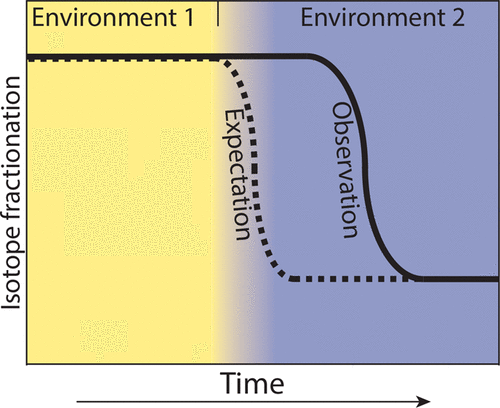当前位置:
X-MOL 学术
›
Environ. Sci. Technol.
›
论文详情
Our official English website, www.x-mol.net, welcomes your feedback! (Note: you will need to create a separate account there.)
Sulfur Isotope Fractionation by Sulfate-Reducing Microbes Can Reflect Past Physiology
Environmental Science & Technology ( IF 11.4 ) Pub Date : 2018-03-15 00:00:00 , DOI: 10.1021/acs.est.7b05119 André Pellerin 1 , Christine B. Wenk 2 , Itay Halevy 2 , Boswell A. Wing 3
Environmental Science & Technology ( IF 11.4 ) Pub Date : 2018-03-15 00:00:00 , DOI: 10.1021/acs.est.7b05119 André Pellerin 1 , Christine B. Wenk 2 , Itay Halevy 2 , Boswell A. Wing 3
Affiliation

|
Sulfur (S) isotope fractionation by sulfate-reducing microorganisms is a direct manifestation of their respiratory metabolism. This fractionation is apparent in the substrate (sulfate) and waste (sulfide) produced. The sulfate-reducing metabolism responds to variability in the local environment, with the response determined by the underlying genotype, resulting in the expression of an “isotope phenotype”. Sulfur isotope phenotypes have been used as a diagnostic tool for the metabolic activity of sulfate-reducing microorganisms in the environment. Our experiments with Desulfovibrio vulgaris Hildenborough (DvH) grown in batch culture suggest that the S isotope phenotype of sulfate respiring microbes may lag environmental changes on time scales that are longer than generational. When inocula from different phases of growth are assayed under the same environmental conditions, we observed that DvH exhibited different net apparent fractionations of up to −9‰. The magnitude of fractionation was weakly correlated with physiological parameters but was strongly correlated to the age of the initial inoculum. The S isotope fractionation observed between sulfate and sulfide showed a positive correlation with respiration rate, contradicting the well-described negative dependence of fractionation on respiration rate. Quantitative modeling of S isotope fractionation shows that either a large increase (≈50×) in the abundance of sulfate adenylyl transferase (Sat) or a smaller increase in sulfate transport proteins (≈2×) is sufficient to account for the change in fractionation associated with past physiology. Temporal transcriptomic studies with DvH imply that expression of sulfate permeases doubles over the transition from early exponential to early stationary phase, lending support to the transport hypothesis proposed here. As it is apparently maintained for multiple generations (≈1–6) of subsequent growth in the assay environment, we suggest that this fractionation effect acts as a sort of isotopic “memory” of a previous physiological and environmental state. Whatever its root cause, this physiological hysteresis effect can explain variations in fractionations observed in many environments. It may also enable new insights into life at energetic limits, especially if its historical footprint extends deeper than generational.
中文翻译:

减少硫酸盐的微生物对硫同位素的分馏可以反映过去的生理状况
通过减少硫酸盐的微生物进行的硫(S)同位素分级分离是其呼吸代谢的直接表现。在产生的底物(硫酸盐)和废物(硫化物)中这种分馏是明显的。减少硫酸盐的代谢响应局部环境中的变异性,其响应由潜在的基因型决定,从而导致“同位素表型”的表达。硫同位素表型已被用作环境中还原硫酸盐的微生物的代谢活性的诊断工具。我们对寻常型脱硫弧菌的实验在分批培养中生长的希尔登伯勒(Hildenborough,DvH)表明,硫酸盐呼吸微生物的S同位素表型在比世代更长的时间尺度上可能滞后于环境变化。在相同的环境条件下分析来自不同生长阶段的接种物时,我们观察到DvH的净表观分馏率最高为-9‰。分馏的程度与生理参数之间的联系较弱,但与初始接种物的年龄密切相关。在硫酸盐和硫化物之间观察到的S同位素分馏与呼吸速率呈正相关,这与众所周知的分馏对呼吸速率的负相关性相矛盾。S同位素分馏的定量模型表明,硫酸腺苷酸转移酶(Sat)丰度的大幅度增加(≈50x)或硫酸盐转运蛋白的较小幅度增加(≈2x)足以说明相关的分馏变化与过去的生理。用DvH进行的时间转录组学研究表明,硫酸盐通透酶的表达在从早期指数期到早期固定期的过渡过程中翻了一番,这为此处提出的运输假说提供了支持。由于它在测定环境中的多个世代(≈1–6)的后续生长中都得到了明显维持,因此我们建议这种分馏效应可充当先前生理和环境状态的一种同位素“记忆”。不管其根本原因是什么,这种生理滞后效应可以解释在许多环境中观察到的馏分变化。它还可以在精力充沛的极限条件下实现对生活的新见解,特别是如果其历史足迹比世代相传更深。
更新日期:2018-03-16
中文翻译:

减少硫酸盐的微生物对硫同位素的分馏可以反映过去的生理状况
通过减少硫酸盐的微生物进行的硫(S)同位素分级分离是其呼吸代谢的直接表现。在产生的底物(硫酸盐)和废物(硫化物)中这种分馏是明显的。减少硫酸盐的代谢响应局部环境中的变异性,其响应由潜在的基因型决定,从而导致“同位素表型”的表达。硫同位素表型已被用作环境中还原硫酸盐的微生物的代谢活性的诊断工具。我们对寻常型脱硫弧菌的实验在分批培养中生长的希尔登伯勒(Hildenborough,DvH)表明,硫酸盐呼吸微生物的S同位素表型在比世代更长的时间尺度上可能滞后于环境变化。在相同的环境条件下分析来自不同生长阶段的接种物时,我们观察到DvH的净表观分馏率最高为-9‰。分馏的程度与生理参数之间的联系较弱,但与初始接种物的年龄密切相关。在硫酸盐和硫化物之间观察到的S同位素分馏与呼吸速率呈正相关,这与众所周知的分馏对呼吸速率的负相关性相矛盾。S同位素分馏的定量模型表明,硫酸腺苷酸转移酶(Sat)丰度的大幅度增加(≈50x)或硫酸盐转运蛋白的较小幅度增加(≈2x)足以说明相关的分馏变化与过去的生理。用DvH进行的时间转录组学研究表明,硫酸盐通透酶的表达在从早期指数期到早期固定期的过渡过程中翻了一番,这为此处提出的运输假说提供了支持。由于它在测定环境中的多个世代(≈1–6)的后续生长中都得到了明显维持,因此我们建议这种分馏效应可充当先前生理和环境状态的一种同位素“记忆”。不管其根本原因是什么,这种生理滞后效应可以解释在许多环境中观察到的馏分变化。它还可以在精力充沛的极限条件下实现对生活的新见解,特别是如果其历史足迹比世代相传更深。



























 京公网安备 11010802027423号
京公网安备 11010802027423号